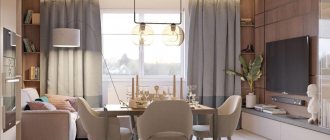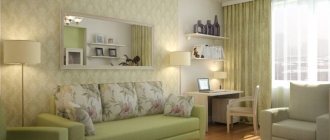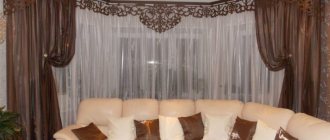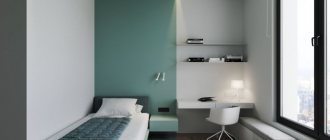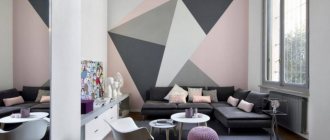Home » Rooms » Living room
Living roomDesignFloorCeilingsInterior styles
Belyaeva Irina
25128 Views
The living room is one of the most important rooms that needs to be equipped even if there is a shortage of free space. A small area imposes many restrictions, but at the same time it gives impetus to the manifestation of imagination and the implementation of unusual design solutions. You can cope with the task of creating a cozy, fairly functional living room if you have the necessary information. Find out more about everything later in the article.
Simple or complex approaches to solving the issue
Creating an original living room in a small area is very difficult. Non-standard solutions, as well as special techniques, will be used.
The easiest option to “add” space to your living room would be to disassemble a wall (or part of it). In this case, the expansion will be achieved by combining the living room with the kitchen or one of the adjacent rooms.
We choose non-standard solutions
Complex approaches are the embodiment of unusual solutions in the area that was originally allocated for the living room. To do this, play with colors and shades, choose suitable furniture and accessories.
Where to begin?
The creation of any interior begins with the design of the floor, ceiling, walls, and the choice of furniture. Having outlined the main direction of the design, you can move on to detailing.
We combine the floor and ceiling with the interior
If the living room is not only small in area, but also requires the combination of several functionally different zones, then this factor must be taken into account from the very beginning of the design. Zoning, if necessary, is performed using the following techniques:
- organization of niches;
- proper arrangement of furniture;
- using wallpaper of several shades;
- placement of partitions;
- use of lighting of various directions and organization;
- organizing a podium in part of the room;
- combining living space with a balcony.
Placement of partitions
The main points in creating a living room interior are based on a suitable choice:
- Lighting.
- Color range.
- Furniture.
- Accessories.
How to arrange furniture in a small bedroom
Arranging furniture in a small bedroom is not an easy task. However, even on several squares you can organize functional space.
How to place the bed
The bed should be located in such a place that the sleeper feels comfortable.
- There should be no drafts nearby.
- To make getting out of bed comfortable, leave a passage of about 70–80 cm.
- If the side of the bed is against the wall, provide a finish that can be easily cleaned.
Mikhail Shaposhnikov
Interior designer
It is important to understand who is the owner of the bedroom - a lark or an owl. If you are used to waking up late, the rays of the sun in the morning will only disturb you. The sun moves from east to west. The morning rays will penetrate first into the western part of the room. There may well be a bed here that belongs to a lark. But if the owner of the bedroom is an owl, it is better for him to sleep in the eastern part of the room, where the sun's rays will reach later.
Ideal layout in the bedroom
Wardrobe and cabinets
The classic option is to place bedside tables on both sides of the bed. However, for small rooms this arrangement is not the best. An alternative to cabinets can be shelves above the headboard.
It’s great if the size of the bedroom allows you to install a wardrobe. If this is not possible, consider placing narrow cabinets on the sides of the bed instead of nightstands.
Bedding is usually stored in a chest of drawers. But sometimes a podium with storage compartments becomes more convenient than a traditional chest of drawers.
Where to store things in a small bedroom
Even in a small bedroom you can find storage space. Here are some ideas:
- Baskets or drawers under the bed.
- Shelves above the bed.
- Open hangers for clothes.
- The space behind the screen where you can place shelves and hangers.
- Podium (raise for the bed) with storage compartments.
- Shelving - unlike closed cabinets, they do not clutter up the space.
Wall decoration: manipulations with prints and shades
One of the most popular ways to decorate walls is wallpapering. To create a successful interior, designers give preference to light colors. Pastel colors will create the effect of free space, spaciousness, and light.
Most often, walls are covered with wallpaper.
Prints
Prints for the living room should be chosen small, not in flashy colors, but with a laconic design. It is not advisable to introduce large bright elements into the interior, not only when decorating walls, but as accessories. A large pattern on the walls will create the impression of a small, cramped space.
Advice For a small room, it is important not to overload it with details, including drawings and details. In order for the space to be harmonious, it is advisable not to use prints en masse. If the wallpaper is chosen in a small pattern, then it is better to choose plain curtains, as well as upholstery. And vice versa.
It’s better not to choose wallpaper with large patterns
Colors
A light shade that dominates the living room may look boring and uninteresting. It is necessary to dilute such a “bland” interior with unusual decor and the use of original solutions. Several colors in the design of a room will help create a dynamic atmosphere and even improve well-being.
When using multiple shades, try to limit the number to five. A good option is to use gradient coloring.
Light wallpaper can look boring
Pastel shades have many tones and undertones. Choosing the most suitable one for the living room should be based on the concept of the room itself, the brightness of the lighting and the objects present in the room.
Warm shades with a yellowish tint have a calming effect on the nervous system and look neutral. They allow you to create a versatile backdrop in your living room.
Cool shades, combined with warm ones, can be used in small rooms without the danger of making them uncomfortable and cold. Warm and cool colors when combined with white allow you to create a bright, comfortable room for living. White can be introduced as an accent.
Dominant white color
Cool shades include:
- lilac;
- grey;
- mint;
- blue.
Cool interior colors
Warm tones include the following:
- golden;
- sand;
- ocher;
- pink;
- beige;
- peach, etc.
Classic color combination
Tip For rooms facing north, it is better to choose warm colors as the predominant ones. For sunny windows, you can pay attention to a cool color scheme, which “quenches” a large amount of sunlight.
Recommendations for decorating a living room
Practical tips:
- Light colors will visually expand the room.
- A print with a horizontal pattern visually “lowers” the ceiling.
- Bright shades can be used as companion colors when placing accents.
- If there are pets, it is better to choose wallpaper with a small print (for example, with a spray effect), as well as a textured top layer. This approach will allow you to hide minor damage caused by animals.
- A vertical strip or other pattern going from bottom to top visually increases the height of the ceiling, but can hide the area.
Light colors will visually expand the room
How to choose a color scheme
Green living room Source houzz.com Using patterns in design Source domoholic.ru/
Wooden covering in the interior Source salvagegaming.us
Lighting for a small room Source houzz.com
Decoration with a minimum amount of furniture Source sdelai-lestnicu.ru A bright solution for a small living room Source dizainexpert.ru Combination of colors in the living room Source ds-lacasa.ru
The color of a small living room plays a decisive role: whether the room will be cozy and spacious or gloomy and uncoordinated. To achieve harmony, designers advise adhering to the following rules:
- All colors should be in harmony with each other. Therefore, it is recommended to use tones that are considered universal. Light shades are used as a base, diluted with other colors.
- When using the color wheel, keep in mind: the primary and secondary colors should be presented in proportions of 60:30, and only 10% should be allocated to the secondary color. For example, black, which will be expressed only in details: table legs, door handles and cabinet fittings.
- It is not recommended to use more than three colors. It is necessary to choose the main one, which will be the most in the interior, and dilute it with the remaining shades. It is considered correct to comply with the following standards: 75% - the main tone, 25% - additional, 5% - the brightest color from the palette.
Highlighting one of the walls: mirrors and photo wallpaper
If you need to visually “expand” the living room space, you can use mirrors. They should not be small, but large, allowing you to create the effect of perspective. An example is the use of furniture with mirrored facades or placing a mirror surface above the sofa.
Highlighting a wall with photo wallpaper is a fashionable and effective technique. Pasting photo wallpaper will help correct the irregular shape of the room, as well as shift attention to the original design. A three-dimensional image will help to visually lengthen a square room or balance a narrow living room.
Highlighting walls with photo wallpaper
Tip In addition to the walls, you can decorate the ceiling in the living room with mirrors.
Highlighting one of the walls of the living room in the relaxation area with a bright color or a catchy pattern of photo wallpaper will help give the room dynamism. Near this wall you can place original decorative items.
Classic
Design in a classic style Source intaer.ru
The main principles of this style are as follows:
- Division into zones. Focus on a group of objects, for example, on a sofa or coffee table.
- Minimum amount of furniture. Classic does not involve the use of bulky walls, shelving, or cabinets.
- Light colors are used to decorate the walls. But if the room is already too light, you can also use dark shades.
Justification for partitions when room space is limited
If the living room has a small area, how justified is it to divide it with the help of additional partitions? If it is necessary to place several zones in one room, for example, relaxation and receiving guests, such a division may be completely justified.
Justified use of partitions
The partitions themselves in the living room can be of two main types:
- Decorative.
- Fundamental.
Partitions can form original arches, transform into niches of interesting shapes, and stand out in color and material.
Partitions can have the most interesting shapes
Decorative partitions
They play not only a functional role, zoning the room, but also a decorative one. They can be decorated using glass, bead pendants, fabric panels, etc. Or shelving with open shelves can be used for books, souvenirs, an aquarium, etc.
If glass is chosen, then most often preference is given to the matte version, as the most versatile. The matte effect is not completely transparent, but allows enough color to pass through and can go with most styles.
Decorative function of partitions
Fundamental partitions
Solid, created over the years, such partitions play the role of a real wall. They are reliable, but have their drawbacks:
- take up quite a lot of space;
- degrade the natural light in the room, especially if there is only one window;
- they are very difficult to dismantle and almost impossible to move.
Here the partitions play the role of a real wall
For a small living room, a fundamental partition is not the best option . It can be used only in cases where other options cannot be implemented.
Stretch ceiling in the living room
Today you can find suspended ceilings in almost every house or apartment. They are typically used to hide or lower a slightly high fixed ceiling. This finishing option also plays a decorative role, because the LEDs hidden in it perfectly highlight and illuminate the space. A stretch ceiling is ideal for a living room; it will create a unique atmosphere in any interior.
In the living room, the ceiling is often a wonderful way to add variety to the interior. In addition to its undoubted decorative characteristics, a stretch ceiling also serves to hide unevenness in plaster or communications. It is also a wonderful way to divide a space thanks to the play of light that can often surprise. Thanks to this finish, you can create intimate lighting with LEDs.
Ceiling: “increasing” the height
The design of the ceiling affects the perception of the entire room. If the height of the living room walls is small, you will have to abandon complex multi-level structures and dark colors. The lighter the shade chosen, the better.
Avoid the pompous ceiling
A feeling of spaciousness can be created using optical illusions in the form of prints on tension structures. It is better to give preference to a satin or glossy finish, which visually adds dimension to the living room. Matte surfaces look more traditional. But with proper lighting arrangement, they are also capable of “raising” the ceiling.
Techniques for visually expanding space
It’s easy to make a room larger by knowing a few secrets from interior designers:
- Avoid large patterns and prints on the walls, give preference to plain surfaces or small patterns.
- Mirrors add light and expand the space. They can be on the wall or in the form of inserts on furniture.
- Don't overload the room with many small details.
- It is acceptable to use gradient wall painting, which will add brightness to the room. Be careful, this technique can visually overload the room.
- Pay special attention to lighting. If there is not enough natural light, add lamps so that there are no dark areas.
Floor decoration
If there is an opportunity to refuse carpeting in a small living room, then it is better to do so. A rug on the floor can break up the space and create a cluttered appearance.
It's better to do without carpeting
If a carpet is necessary, then it is recommended to try to decorate the interior based on simple rectangular models. A rectangle can harmonize the space and give it the correct shape.
Advice It is better to give preference to a single-color coating or one that has a smooth transition from dark to lighter tones.
How to choose a style
Decoration in beige Source art interior.
Moscow The design of a small living room forces you to end up with an abundance of furniture, bulky cabinets, and some accessories, so the universal styles used in design are:
- Classical.
- Hi-tech.
- Scandinavian.
- Loft.
Combination of living room with kitchen
This option is considered a fairly simple solution to the problem of small space. The combination of two rooms can be done using an expanded opening between the rooms or in the form of an arch, combined with a bar counter.
Zoning of space in this case can be emphasized by different designs of walls, floors and even ceilings, as well as the use of different textures and shades. The commonality of design can be achieved by a kind of “flowing” of colors from one room to another with differences in tones or patterns. In this case, the combined premises must be organized in the same style.
Option to combine the kitchen with the living room
Tip The visual separation of the kitchen and living room areas can also be emphasized with a curtain made of wooden beads or gauze fabric gathered on one side.
If the living room is combined with a kitchen, then you should pay more attention to the choice of flooring. In this case, it may be necessary to remove the long-pile carpet, leaving the laminate or linoleum exposed in the living room area.
We pay attention to the choice of flooring
The kitchen floor may differ from the flooring material in the living room area. Non-slip tiles are better for the kitchen. It has high resistance to influences, including water.
Divide the living room into zones
Determine the functional areas and place them wisely! In small apartments, the living room often plays the role of a bedroom, an office, or is combined with a kitchen. Since you probably won’t be able to install a partition due to the small area, use furniture and finishing materials for zoning.
You can define a relaxation area using a sofa, placing its back or side to the surrounding environment. The kitchen work area will be separated by a bar counter, and the sleeping area can be hidden behind a shelf with books, magazines or accessories.
Zoning a small living room with the help of lighting and finishing materials that differ in color and texture looks impressive. For example, a wall with a TV can be decorated with a contrasting color, photo wallpaper, or decorative stone.
80 living room design ideas in Khrushchev (photo)
Optical illusions: choosing the right furniture
The use of design techniques allows for visual correction of the room. One of the optical illusions is the choice of small furniture.
Key items to highlight
The center of the composition can be a sofa or, for example, a dining table. If a large piece of furniture is surrounded by smaller ones (chairs, small armchairs, etc.), then the composition will not look overloaded.
We place the accents correctly
Do you have a plan?
It is better to arrange interior items according to plan. This will allow you to distribute the free space correctly and avoid purchasing unnecessary items.
The table and cabinet for the living room should be small and compact. A large sofa creates comfort, but may be inappropriate in a small area.
Advice A good solution could be a folding sofa. This will allow you to organize additional sleeping space for family members or guests.
A good option is a folding sofa
Furniture organized like transformers will help you “outwit” the space:
- tables with a sliding or folding mechanism;
- folding sofas;
- chairs that can change their size;
- modular furniture.
Corner sofa: yes or no?
Should you choose a corner sofa for your living room? It economically fills space and is laconically placed in a small room. One of the disadvantages is the impossibility of rearranging it, since the size of the living room imposes strict restrictions.
Corner sofa in a small living room
Additional storage systems can be organized in the form of drawers under the sofa, or in the form of hanging shelves in the walls . Despite its small size, you can even find space for a wardrobe in the living room.
Save space in the living room
It is important to adhere to the rule that all elements introduced into the interior should not look bulky. The largest of them are best placed along the walls.
This approach will save free space by removing all unnecessary items from open shelves. Mirror doors will be a good solution, visually adding volume. If the mirror does not fit the interior, you can try to introduce into the interior a model with frosted glass on the front or a pattern running along the front panel of the cabinet.
It's better not to clutter an already small room
A solid wall of furniture located along one of the walls in the living room will take up too much free space. It would be better to replace it with a slide with open, lightweight shelves that have simple organization and a minimum of decorative elements.
It is best to choose a furniture set of a light color that matches the shade of the walls . Open shelves can be used in limited quantities.
Light colored furniture set
No one can deny practicality
A beautiful interior in which you are not embarrassed to welcome guests is, of course, good, but what about practicality? Even in a small living room, you should provide space for your favorite books and music CDs, shelves for placing exhibits of your collection or souvenirs from distant countries.
Storage systems must be present, at least to a minimum extent. This is especially important if the rest of the apartment is small in area. If it is likely that guests will stay overnight, a folding sofa becomes necessary.
When there is room for guests
Fireplace in the living room interior
A small amount of furniture can be diluted by arranging a decorative fireplace, installing an original floor lamp or introducing other items that will dilute the atmosphere. Glass shelves and table top add lightness to the design. But this option is not suitable for families with small children.
Tip Indoor niches are best used for arranging furniture. Don't leave them empty.
Fireplace in the interior
Features of a small living room
Modern design ideas for a small living room allow the owner of an apartment or house not to be limited when choosing style, decor or color schemes. Even in a small room you can create a comfortable and cozy atmosphere and provide the necessary conditions for proper rest for your household. Of course, the interior of a small living room is distinguished by an abundance of light colors, light sources and compact furniture. The main condition when decorating a small space is that you should not overload the decor of the room; it is important to maintain free zones.
As mentioned earlier, the key feature is the abundance of light sources, because artificial lighting fills the room with light, making it more spacious. The absence of contradictions and sharp contrasts is important; the interior lines should be laconic and smooth. If the area of the room is less than 15 square meters, then there is no room for unnecessary decoration. Paintings and photographs, thick curtains and bulky furniture - all this overloads the interior, “killing” the feeling of spaciousness and comfort.
In order for the interior not to seem boring, it is important to use some tricks, for example, prints, abstractions and geometric patterns. When finishing the floor, ceiling and walls, it is important to choose materials that can adjust the shape of the room, making it more spacious. If the room is narrow, then vertical stripes are used on the walls, and to decorate square rooms, finishing with a wide longitudinal stripe is used.
As for furniture, it should be comfortable and functional; it is better to remove unnecessary items. When dividing a small living room into zones, you can use screens and partitions, glass or mirror elements. Mirrors, glossy surfaces, and suspended ceilings can visually enlarge the space.
Lighting selection
Creating a living room background and choosing furniture are the main points in shaping the interior. But without the right lighting, all the efforts made may not have an effect.
A large massive chandelier is a spectacular addition to a spacious room, but it is not at all suitable for a limited living room area. Spot lighting can be considered as a good option. This solution is not only practical, but also relevant in the light of fashion trends in interior design.
Chandelier is a great addition to the design
Spot lighting can go along the edge of the ceiling, be located along the perimeter of multi-level structures, or highlight the podium. The main goal of lighting planning is to prevent the formation of unlit dark corners.
Loft
Room design in the loft style Source dizainexpert.ru
This style is famous for large windows, rough lines, minimal decoration, eclectic furniture and large quantities of metal parts. If you want to make a living room in a loft style, then take into account the following recommendations:
- The layout should be open with a minimum number of partitions.
- Non-standard street style decoration options can be used. Graffiti, posters, abstractions or road signs will all be appropriate.
Another feature is that the floors in the room cannot be finished; bare concrete is the most acceptable option. But of course it is not suitable for living space. Therefore, parquet or floorboards are used as covering. The wood must be varnished. The walls traditionally remain in their original form. Brick, concrete surface, tiles - all this does not matter. An alternative could be wallpaper with an imitation of such a coating. The ceiling is traditionally white. The best materials for ceiling coverings are raw concrete, metal, wood.
Living room design style
Harmony of design can be achieved by combining all elements in accordance with a certain style.
Minimalism
Most often, minimalism is preferable for a small living room. It is distinguished by laconic forms, neatness and a limited number of pieces of furniture.
When everything is in minimalism style
Modern materials and a minimum of decor in a minimalist interior should be combined with neutral shades. Advantage may be given to simple forms of furniture.
Provence
Provence is characterized by large space, plenty of air and unity with nature. A casual style can be difficult to achieve in a small space, especially with low ceilings and limited natural light.
This room design can resemble a warehouse due to the limited space and the abundance of all kinds of accessories typical of Provence. For a small living room, you should try not to crowd the space with furniture or use too many decorative elements.
Ease of Provence
When decorating the walls, it is better to give preference to decorative plaster, light pastel colors typical of the French south and small floral prints on textile elements.
Aged furniture is one of the features of the Provencal style in living room design. The play of solar reflections on surfaces is achieved by the competent use of light colors on the surfaces of antique (or artificially aged) furniture.
Provence requires the use of natural materials in creating the interior: from the design of walls and ceilings to accessories.
Naturalness of materials
Classic
A classic interior in a limited area is very difficult to recreate in full. Classic requires solid, high-quality furniture, the use of natural materials and noble shades.
There should not be a lot of decor in such an interior. Antiques and things with history are well suited for decoration:
- heavy candlesticks;
- antique clock;
- porcelain figurines;
- boxes with inlay, etc.
An original and timeless classic
A small area should be used sparingly; little furniture is needed:
- sofa;
- a pair of armchairs;
- Coffee table.
It is permissible to organize an imitation of a fireplace. It is advisable to decorate the walls using wood or wallpaper in classic colors.
We add nobility with the help of expensive decorative items
High tech
Modern details and high-tech chrome metal surfaces are complemented by electronic technology and bright finishes. Decoration in this style is most often preferred by young families and active people.
Japanese style
Low, squat furniture of laconic forms in the Japanese style is made in light and dark natural shades. The decor must comply with Japanese traditions:
- image of hieroglyphs;
- vases;
- ikebana;
- bansai;
- traditional Japanese screens and other characteristic elements.
Accessories: mirrors, paintings, plants
Accessories for a small living room don’t just look impressive, but they also visually expand the space of the room. The most interesting details are the mirrors on the furniture, inserts on the ceiling or panels on the walls. They create an optical illusion of vastness and limitlessness.
Paintings are the main decoration of the living room, but you need to choose them wisely.
On light walls without any special texture or pattern, images in contrasting colors look good; on wallpaper in the Provence style, you can place photographs of the family or reproductions that match the design.
You shouldn’t overload a small living room with plants - it’s enough to place, for example, a tall palm tree near the window, and place several pots with dwarf plants on the shelves or on the coffee table near the armchairs. If the layout allows, then it is best to put all the flowers in a separate niche.
With large plants, you should follow a simple rule: no more than three. As for the small ones, there can be as many of them as the owner can regularly care for, but they should not clutter up the entire usable area.
Recommendations
Saving space and its rational use should include the proper arrangement of each item:
- It is better to hang the TV on a free wall opposite the sofa;
- highlight the window with decoration, but without pomp;
- It is advisable to choose thin tulle and avoid heavy curtains;
- It is recommended to use Japanese roller blinds;
- with a large amount of decor, the design of the walls should be neutral;
- It is better to choose a flat aquarium.
VIDEO: Updating the living room design
Living room interior
Ready-made solution for your design
Selection of filler
The quality of the sofa's filling directly determines the comfort of rest, as well as the duration of its service life.
Professionals consider the main advantage of using a spring block as a furniture filler to be durability, convenience, and reliability of structures. But such fillers also have certain disadvantages.
For example, a spring unit includes a plurality of springs, each located in a separate cell. A sofa with a similar filling is quite soft, so it can be recommended for older people.
Let us note that its reliability and ease of use depend not only on the number of springs available in the design of a corner sofa. There are many other factors, for example, the density of the material, its wear resistance.
For those owners of small apartments who plan to save material resources on purchasing new upholstered furniture, professional interior designers advise choosing models with synthetic filling:
- padding polyester;
- foam;
- synthetic fluff;
- spandboard;
- holofiber
If you plan to purchase corner upholstered furniture for a short period of time, it is quite possible to choose a model with solid filling.
Despite the fact that many manufacturers of upholstered furniture currently choose synthetic materials as fillers, among them there are wear-resistant and reliable types:
- foam rubber made by dense compression;
- polyurethane foam;
- latex;
- polyurethane foam, which is an analogue of latex;
- Periotec, intended for people with allergies

